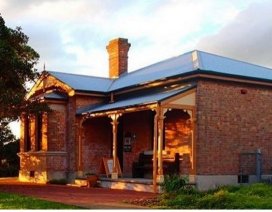
ASH ISLAND – SCHOOLS MASTERS HOUSE
built in the mid 1890s
78 School House Road, Kooragang N.S.W. 2304
The Schoolmasters house has local heritage significance. It was built in the mid 1890s to house the schoolmasters who administered and taught at the Ash Island Public School located a short walk to the west. The house has stood through floods, been the home for many tennants and during World War II was leased by the RAAF. Sturdily built of double brick, the house has Baltic Pine ceilings, tallowwood floors, cedar doors and windows, and three marble fireplaces.
Significantly it is the last of the buildings on the islands in the estuary still standing on its original footprint. When the last tenant left the house in 1997 it underwent restoration to return to its near original condition. For over 20 years it was the administration and information centre for the Kooragang Wetland Rehabilitation Project. The Friends of the Schoolmasters House took over the lease on July 1st 2018.
‘Ash Island is beautiful and the integrity of the rehabilitation is really important to us,’ tells Julia Brougham, who volunteers with Friends of the Schoolmaster’s House Inc (FOTSHINC). The group of volunteers are former Kooragang Landcare Volunteers and supported the Kooragang Wetland Rehabilitation Project (KWRP) which began in 1993. They continue the KWRP legacy of redressing the loss of habitat in the internationally significant wetlands in the Hunter Wetlands National Park by restoring Ash Island’s native vegetation.
The FOTSHINC team and the Kooragang Landcare Volunteers get together on the third Sunday of each month to plant in the wetlands. ‘When the Hunter Local Land Services decided not to continue the lease on the old Schoolmasters House, we didn’t want any of the library of carefully measured and recorded information of the last 25 years to be dispersed so we formed a new incorporated Landcare NSW group and call ourselves the Friends of the Schoolmasters House. We’re preserving and digitally archiving the library and the history of Ash Island from a botanical point of view and a people one,’ says Mrs Brougham. ‘Port Waratah helped us buy equipment so we can now scan all the documents and images that have been accumulated since 1993.
There’s maps, documents and pictures, and we can see what was there then, and what’s there now. ‘We’re attracting new volunteers, including some from Hunter Volunteer Centre and those on NDIS programs. One of our volunteers is a trained botanist and she’s created a photo database of the plants on the island. We know the plants that were originally there too because Helena Scott, the daughter of the first land grant owner on Ash Island, was a natural history illustrator. In 1862 she rambled over the island and recorded all of the plants she saw and created an authoritative first-hand list that we now use as a reference for our planting. It’s a rare thing for any landcare group to have.
We’re very lucky.’ The Friends of the Schoolmasters House also researches history, genealogy, and the history of families on Ash Islands. ‘We want to save and archive everything we do. We’re getting whatever information we can from whoever is left that knows about it, from photos to personal accounts and we’re developing that archive as well. Port Waratah’s support enabled us to buy the scanners for the digitising, and good cameras so we can capture living histories. We talk to the former residents of Ash Island, from the old farming families, not that there’s many of them left these days. They remember the farming days when most of the original vegetation was gone and it was paddocks. It’s alluvial soil so it’s very rich and they got good crops of fruit and vegetables, and they ran dairy farms.
Their stories are interesting and people remember their life with deep nostalgia, but looking at the photos, some of those farmers were very hard up. They tell us it was a very hard life. What they remember with great affection is the sense of community they had.’ The Schoolmasters House library is a huge resource for school and university students and academics too. ‘We are actively working to become a content provider to the National Library’s Trove so that our information becomes available to everyone, even globally accessible.’ Friends of the Schoolmasters House is a landcare group that works to improve biodiversity and restore native vegetation in the Hunter River estuary.
